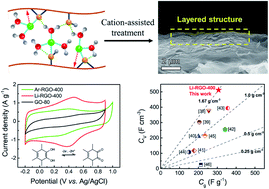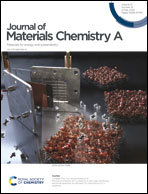Li+-assisted treatment of graphene oxide for ultrahigh volumetric performance supercapacitors†
Abstract
Graphene-based materials exhibit high gravimetric capacitance; however, their volumetric capacitance is generally poor due to the low packing density. In this paper, a new strategy named metal cation-assisted treatment (CAT) of graphene oxide (GO) was proposed to prepare compact reduced graphene oxide (RGO) powder with high volumetric capacitance. The presence of cations (Li+ was used in this work) not only promoted the assembly process and inhibited the expansion of RGO sheets during heat treatment, but also contributed to the enhancement of the relative content of the aromatic C–OH group. As a result, the Li+-assisted treated RGO exhibits a high packing density of 1.67 g cm−3 and high relative content of the C–OH group. Due to the high packing density and abundant C–OH groups, the values of the gravimetric and volumetric capacitance of Li+-assisted treated RGO reached 307 F g−1 and 512 F cm−3 @ 0.1 A g−1, respectively. The gravimetric energy density of the symmetric supercapacitor reached 9.5 W h kg−1 @ 60 W kg−1, while the volumetric energy density of the active material reached 15.9 W h L−1. This report provides a new strategy to design desirable structures using various cations beyond Li+ to improve the supercapacitive performance of graphene-based materials, which exhibits immense potential for commercial application due to its simplicity, high efficiency, and being environmentally friendly.



 Please wait while we load your content...
Please wait while we load your content...